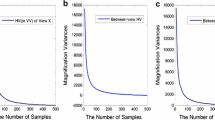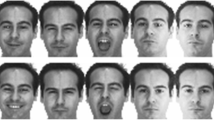Abstract
Multiset canonical correlation analysis (MCCA) can simultaneously reduce the dimensionality of multi-set data. Thus, MCCA is a very important method for multiple feature extraction. However, in small sample size problem, covariance matrix cannot be estimated accurately so that the projections in MCCA are usually not optimal in such case for recognition purpose. In order to address this problem, we propose a novel method called orthogonal MCCA based on fractional-order (FbOMCCA). Compared with MCCA, there are two improvements in FbOMCCA: firstly, orthogonality constraint, as a popular criterion used in feature extraction, is introduced. It makes multiset canonical projective vectors less affected by poor estimation of covariance matrix. Secondly, inspired with the idea of fractional order, we incorporate fractional-order within-set and between-set scatter matrices to further reduce the deviations of sample covariance matrices. Furthermore, a novel algorithm based on eigen decomposition is proposed to gradually obtain multiset canonical projective vectors. Experimental results on UCI multiple feature dataset, and CENPARMI handwritten Arabic numerals database show that FMOCCA has better recognition rates and robustness than existing MCCA-related methods.



Similar content being viewed by others
References
Ross A, Jain AK (2004) Multimodal biometrics: an overview. In: Proceedings of 12th European signal processing conference, pp 1221–1224
Yang J, Yang JY, Zhang D, Lu JF (2003) Feature fusion: parallel strategy vs. serial strategy. Pattern Recogn 36:1369–1381
Chen X, Chen S, Xue H, Zhou X (2012) A unified dimensionality reduction framework for semi-paired and semi-supervised multi-view data. Pattern Recogn 45:2005–2018
Chaudhuri K, Kakade SM, Livescu K, Sridharan K (2009) Multi-view clustering via canonical correlation analysis. In: Proceedings of the 26th annual international conference on machine learning, pp 129–136
Fukunaga K (1990) Introduction to statistical pattern recognition. Academic Press, New York
Hotelling H (1936) Relations between two sets of variates. Biometrika 28:321–377
Kettenring JR (1971) Canonical analysis of several sets of variables. Biometrika 58:433–451
Nielsen AA (2002) Multiset canonical correlations analysis and multispectral, truly multitemporal remote sensing data. IEEE Trans Image Process 11:293–305
Hasan MA (2009) On multi-set canonical correlation analysis. In: International joint conference on Neural Networks, 2009 (IJCNN 2009), pp 1128–1133
Sun QS, Zeng SG, Liu Y, Heng PA, Xia DS (2005) A new method of feature fusion and its application in image recognition. Pattern Recogn 38:2437–2448
Sun QS, Liu ZD, Heng PA, Xia DS (2005) A theorem on the generalized canonical projective vectors. Pattern Recogn 38:449–452
Sun T, Chen S, Yang J, Shi P (2008) A novel method of combined feature extraction for recognition. In: Eighth IEEE international conference on data mining, 2008 (ICDM’08), pp 1043–1048
Sun TK, Chen SC (2007) Locality preserving CCA with applications to data visualization and pose estimation. Image Vis Comput 25:531–543
Sun LA, Ji SW, Ye JP (2011) Canonical correlation analysis for multilabel classification: a least-squares formulation, extensions, and analysis. IEEE Trans Pattern Anal Mach Intell 33:194–U204
Kim TK, Kittler J, Cipolla R (2007) Discriminative learning and recognition of image set classes using canonical correlations. IEEE Trans Pattern Anal Mach Intell 29:1005–1018
Yuan YH, Sun QS, Zhou QA, Xia DS (2011) A novel multiset integrated canonical correlation analysis framework and its application in feature fusion. Pattern Recogn 44:1031–1040
Jing XY, Li S, Lan C, Zhang D, Yang JY, Liu Q (2011) Color image canonical correlation analysis for face feature extraction and recognition. Signal Process 91:2132–2140
Fu Y, Cao L, Guo G, Huang TS (2008) Multiple feature fusion by subspace learning. In: Proceedings of the 2008 international conference on Content-based image and video retrieval, pp 127–134
Su Y, Fu Y, Gao X, Tian Q (2012) Discriminant learning through multiple principal angles for visual recognition. IEEE Trans Image Process 21:1381–1390
Ye JP (2005) Characterization of a family of algorithms for generalized discriminant analysis on undersampled problems. J Mach Learn Res 6:483–502
Chu DL, Goh ST (2010) A new and fast orthogonal linear discriminant analysis on undersampled problems. Siam J Sci Comput 32:2274–2297
Cai D, He X, Han J, Zhang HJ (2006) Orthogonal laplacianfaces for face recognition. IEEE Trans Image Process 15:3608–3614
Kokiopoulou E, Saad Y (2007) Orthogonal neighborhood preserving projections: a projection-based dimensionality reduction technique. IEEE Trans Pattern Anal Mach Intell 29:2143–2156
Gao Q, Ma J, Zhang H, Gao X, Liu Y (2013) Stable orthogonal local discriminant embedding for linear dimensionality reduction. In: IEEE transactions on image processing: a publication of the IEEE Signal Processing Society
Foley DH, Sammon JW Jr (1975) An optimal set of discriminant vectors. IEEE Trans Comput 100: 281–289
Roweis ST, Saul LK (2000) Nonlinear dimensionality reduction by locally linear embedding. Science 290:2323–2326
Shen XB, Sun QS, & Yuan YH (2013) Orthogonal canonical correlation analysis and its application in feature fusion. In: Information Fusion (FUSION), 2013 16th International conference on IEEE, pp 151–157
Yuan YH, Sun QS (2013) Fractional-order embedding multiset canonical correlations with applications to multi-feature fusion and recognition. Neurocomputing 122:229–238
Duchene J, Leclercq S (1988) An optimal transformation for discriminant and principal component analysis. IEEE Trans Pattern Anal Mach Intell 10:978–983
Blake C, Merz CJ (1998) UCI repository of machine learning databases [http://www.ics.uci.edu/~mlearn/MLRepository.html], vol. 55. Department of Information and Computer Science, University of California, Irvine, CA
Franke J, Lam L, Legault R, Nadal C, Suen C (1993) Experiments with the CENPARMI database combining different classification approaches. In: 3rd International workshop on frontiers in handwriting recognition, pp 305–311
Hou S, Sun Q, Xia D (2011) Feature fusion using multiple component analysis. Neural Process Lett 34:259–275
Zhong-Shan H, Zhen L, Jing-Yu Y, Ke L (1999) Handwritten digit recognition based on multi-classifier combination. Chin J Comput 22:369–374
Acknowledgments
This work is supported by the National Science Foundation of China under Grant No. 61273251.
Author information
Authors and Affiliations
Corresponding author
Rights and permissions
About this article
Cite this article
Shen, X., Sun, Q. Orthogonal Multiset Canonical Correlation Analysis based on Fractional-Order and Its Application in Multiple Feature Extraction and Recognition. Neural Process Lett 42, 301–316 (2015). https://doi.org/10.1007/s11063-014-9358-5
Published:
Issue Date:
DOI: https://doi.org/10.1007/s11063-014-9358-5




